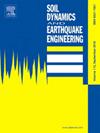Systematic seismic simulation for nuclear island buildings in CPCRF site: Insights into interfacial discontinuity
IF 4.2
2区 工程技术
Q1 ENGINEERING, GEOLOGICAL
引用次数: 0
Abstract
Nuclear facility sites built on soft deposits often adopt a combined piled cushion raft foundation (CPCRF) to enhance bearing capacity. However, separation and slip at the raft–bottom interface is inevitable in refined seismic simulations of weakly anchored nuclear island buildings (NIBs). Multiple factors related to both the structure and foundation influence the interface behavior. To address this, a structure–interface–soil nonlinear interaction model was developed, incorporating interfacial discontinuity characteristics, tri-directional wave inputs, and a stable semi-unbounded condition. The validity of the wave–field simulation method and the interface model were confirmed through theoretical comparisons. Using the AP1000 NIB at a specific CPCRF site as an example, the practicability of the model was validated, and key behavioral patterns were identified. In the static-seismic process, correlations between interface behavior, pile damage, and structural vibration were quantitatively elucidated. When seismic intensity exceeded design limits, the minimum instantaneous grounding ratio decreased rapidly. Structural vertical acceleration nearly doubled, and the frequency band of peak horizontal vibration shifted to higher frequencies. Interface behavior strongly correlated with slip stability and pile body damage. These findings indicate that interfacial discontinuities at the raft's bottom pose safety risks warranting further investigation.
求助全文
约1分钟内获得全文
求助全文
来源期刊

Soil Dynamics and Earthquake Engineering
工程技术-地球科学综合
CiteScore
7.50
自引率
15.00%
发文量
446
审稿时长
8 months
期刊介绍:
The journal aims to encourage and enhance the role of mechanics and other disciplines as they relate to earthquake engineering by providing opportunities for the publication of the work of applied mathematicians, engineers and other applied scientists involved in solving problems closely related to the field of earthquake engineering and geotechnical earthquake engineering.
Emphasis is placed on new concepts and techniques, but case histories will also be published if they enhance the presentation and understanding of new technical concepts.
 求助内容:
求助内容: 应助结果提醒方式:
应助结果提醒方式:


